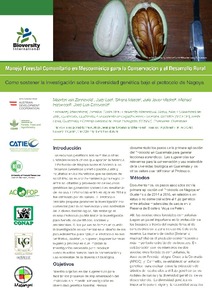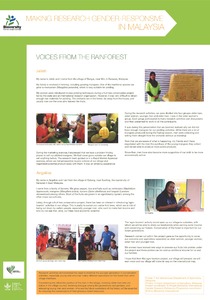Silvicultura comunitaria
AGROVOC URI:
Livestock and deforestation in Central America in the 1980s and 1990s: a policy perspective
This study analyses seven factors used to explain the conversion of forest to pasture in Central America between 1979 and 1994: 1) favourable markets for livestock products; 2) subsidised credit and road construction; 3) land-tenure policies; 4) limited technological change in livestock production; 5) policies which reduce timber values; 6) reduced levels of political violence; and 7) characteristics specific to cattle which make conversion attractive. Deforestation rates in Central America declined in the 1980s, but remained high.
Manual praktek mengelola hutan dan lahan: suatu kombinasi pengetahuan tradisional masyarakat Dayak Kenyah dengan ilmu-ilmu kehutanan dan pertanian
This simple manual is intended for general guidelines on traditional methods in managing natural resources. It is based on the indigenous/traditional knowledge of people of Dayak Kenyah Uma' Jalan society, East Kutai, Kalimantan, Indonesia. Local traditional knowledge is one of the important components to utilise and conserve the natural resources. This manual shows how to prepare the land for planting food crops, community forest management procedures and fire prevention.
Managing forests and improving the livelihoods of forest-dependent people: reflections on CIFOR’s social science research in relation to its mandate for generalisable strategic research
CIFOR has been actively engaged in field research in Indonesia focussing particularly on the role of forests and forest products in generating sustainable livelihoods for local users. Issues such as incentives and institutional structures for equitable and sustainable management systems have been highlighted in this research, which has been undertaken with the active co-operation of local NGOs.
Managing natural forests for sustainable harvests of mahogany (Swietenia macrophylla): experiences in Mexico's community forests
In 2002, mahogany (Swietenia macrophylla) was listed on Appendix II of CITES (the Convention on International Trade in Endangered Species). This requires that all producing countries define and implement sustainable production systems for mahogany, the most commercially important neotropical timber, which is still harvested from natural forests. The only serious efforts to produce mahogany sustainably from managed natural forests are those of communities in Quintana Roo, Mexico, which control 800,000 of natural production forests.
Managing smallholder teak plantations: field guide for farmers
The typical practice by smallholder teak growers of letting trees grow without management input has resulted in poor quality plantations. Various questions arise when farmers start to better manage their teak plantations. This book provides practical guidance in addressing these questions by explaining in detail the techniques of parent tree selection, seed preparation, seedling production, planting, fertilising, thinning, pruning, controlling pest and disease and harvesting. To be more easily understood, the descriptions are complemented by illustrations, photographs or tables.
Luz de America: comunidad y biodiversidad Amazonica
Problems with governance of forests are closely linked to incompatible interests between different stakeholders. Having a clearer understanding of the relative importance of forest landscape functions among stakeholders can bring much clarity about why governance problems persist. The voice of the weakest actors is often insufficiently heard in decision-making processes that affect how stakeholders can use forests.
Making sustainability work for complex forests: towards adaptive forest yield regulation
Criteria and indicators (C&I) have been worldwide accepted as a way to conceptualize and measure sustainability of forest management. Various C&I sets or standards were formulated by different organizations and processes such as ITTO, CIFOR, FSC, ATO and Montréal Process. These standards, particularly in the production aspect, underline the sustained forest yield principle and the importance of using permanent sample plot data to regulate forest yield.



